List of Authors
>>About this blog
Recent blog post
|
[CAM]
February 25, 2016 12:00
The other day, he appeared on "Chuo FM" and "I love Chuo-ku" and talked a little about "Hyowa clogs" and "Shokutei Nijo" in Kafu. So, I thought about what time I posted on this blog before, and when I checked it, it was on November 30, 2015.
Then, for about three months, if you stroll around Chuo-ku on the right of the wind "Hyori Geta" or "Shokutei Nijo", you will become quite familiar with the old place names that have disappeared now. Become.
I would like to record the previous sentence again.
"I don't have any obligation or responsibility to do this, so it's just like retirement. As I sent that day, one of the results of devising various ways to spend money without going out to the world, do not need someone, do not need someone, and swallow yourself alone, was a wandering around the city. " (13-301)
And "Sunday clogs" is a walking note that spells what the wind felt in the daily "hanging walk".
In the "Introduction", "I'm about a year old at the beginning of the summer of 1914, serialized in the magazine Mita Literature every month," says, "When I'm ready to go out to the world, I'm going to be a scenic view of the city, and there's no trace that has already been destroyed. " That's why he says, "Let's tell the story of the dream world that will be the tide of yesterday, and this small book, fortunately, will it be a seed of the later day or grass."
Indeed, after that, the Great Kanto Earthquake of 1923 (1923), the U.S. military raid in 1945, and the Tokyo Olympics in 1964, it has been a long time since "the time when this paperboard is formed and it will appear in the world." Now, "I have been able to read this 9th anniversary, and I have already been destroyed.
The scenery in Chuo-ku does not appear so much, but I would like to pick up some of them.
"Edo famous places do not have landscapes or architecture that must be proud of for a long time. ・・ ・ Tsukuda Island, which relocated Sumiyoshi, did not endure the history of Sobashi on a few Kishi Himematsu's shore ... The corner was the only masterpiece of Edo famous places that was only sunny Fuji. . " (300)
"A row of trees is the most effective in downtown areas. Ginza Komagata Ningyocho Dori's willow tree shades and summer night stalls are worthy of a large industrial factory under the Fukidori star without a blowing winder. " (315)
`` Shirakawa Rakuo, a gunshot, is one of the Edo Meien, along with Koishikawa's Korakuen, is one of the Edo Meien, but nowadays the Navy's military members gather and drink. It's a thing of a club that drinks sake. " (320)
"Every time I walked along Nihonbashi Odori and looked at Mitsui Mitsukoshi and other high American-style shops that compete in this area, I knew what a businessman in Tokyo truly called Nihonbashi and Surugacho, if I had a legendary interest in this, I would have even thought of preserving the distant view of Mount Fuji from a busy city. (327)
"In discussing the waters of Tokyo, the first is the sea bay of Shinagawa, the second is the natural river such as the Sumida River Nakagawa Rokugo River, the third is the Edogawa River of Koishikawa, the Kanda River of Kanda, and the Otonashi River of Oji, the fourth is the Shitaya Shinsho Nihonbashi Kyobashi Shitaya, the fourth is the beauty of Shinindigo dyeing. (332)
Walking and walking are now walking in the wind, would it be walking? Kafu still says that he should use money because he has money, but in my case, he said that he has no genuine money, and said, `` As I send that day, I will not go to the public and I will continue to walk around Chuo-ku in the future as a method of swallowing myself without requiring me. "
[CAM]
February 24, 2016 16:00
I love Central FM! I appeared in "Chuo-ku". This is the second time since June last year. By the time it is broadcast, the cherry blossoms may have already begun to fall after full bloom.
The questionnaire submitted before the performance will be published below.
・Self-introduction (Recent status report, favorite places in Chuo-ku, etc.)
I've been walking around the city for the past year since I became a correspondent.
We participated in the "Chuo-ku Marugoto Museum" last November, but as a preliminary survey for that purpose, we walked consistently along Showa-dori, Shin-ohashi-dori St., etc., and about the place names in the city "Points and lines" have become quite consistent.
As an elderly person living a poor life, visiting historic sites in the city and taking photos is an "invitation" for outings, which tend to be troublesome. I'm fascinated by the state of the wind.
"I don't have any obligation or responsibility to do this, so it's just like retirement. As I sent that day, one of the results of devising various ways to spend money without going out to the world without requiring someone to spend money and swallow yourself alone without needing someone, was a wandering around the city. "("Hyori Geta "13-301).
"Chuo-ku" is the original "Edo", and Tokyo has abundant historical sites and historic sites, and has a built-in depth on both old and new sides, which has an advanced downtown area called Nihonbashi and Ginza. It is attractive that it is.
・Today's blog introduction (Where and why did you cover it?) Introduction of places, etc.)
I go to the site and take pictures to actually see and observe buildings that cannot be easily perceived by books and photographs alone.
・ Please tell us your impressions through this interview (recommended highlights, behind-the-scenes, etc.)
"Monoshiri Encyclopedia" introduces 17 walking courses in the city, but if you actually walk these, you will be able to recognize the place names in the city with your own.
・ Where do you want to go next? (Introducing shops, events, famous places, etc.)
I would like to go further around the famous places in the city and deepen my knowledge of its history.
Central FM's studio in the basement of Tokyo Squareware
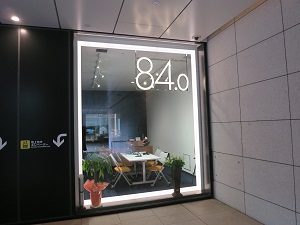
[CAM]
February 23, 2016 12:00
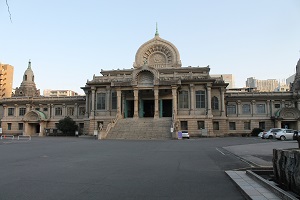 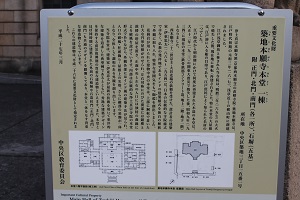
Important Cultural Properties
main hall, Tsukiji Honganji
Attached main gate, north gate, south gate (one place each), stone wall (five units)
Location 3-15-1 Tsukiji 7, Chuo-ku, Chuo-ku
Tsukiji Honganji Temple, a temple under the direct control of the Jodo Shinshu Honganji Temple (Kyoto Nishi Honganji Temple), was founded in Yokoyamacho, near Asakusa in 1617 (1617) during the early Edo period.
This temple, called Edo Asakusa Gobo, was destroyed by the great fire of 1657 (1657), and was relocated and rebuilt to its current location. In particular, the large roof of main hall was a landmark for ships entering Edo Minato, and was one of the most well-known landmarks of the Edo people.
The wooden main hall, which was rebuilt several times between the Edo and Meiji periods, was burned down by the Great Kanto Earthquake of 1923 in 1923 and then became the current main hall (reinforced concrete, two floors above ground and one floor below ground) in 1934.
ITOCHU Ta (1867-1954), an architect of the designer at the request of Nishi Honganji Temple's 22nd lord, Ko Otani Hata, created the temple complex with a unique interpretation of Indian architecture, which was the birthplace of Buddhism, instead of traditional Japanese temple style.
main hall, located in the center of the granite building, has a huge circular roof with a copper plate on the top, a bell tower and a drum tower on the symmetrical wings, and a unique curve gable at the center of the front and the left and right entrances. Although the interior is in the main hall style of the traditional Jodo Shinshu temple, Indian-style architectural techniques are seen in each part of the exterior, and the gables at the entrance (hafu), stills on the roof, and detailed decorations are integrated to create a harmonious appearance as a whole.
The main hall of this temple is a typical example of the architect ITOCHU Ta pursuing Orient-style architecture using the latest technology, and it can be said that it is a valuable building during the reconstruction period that retains excellent architectural design. In addition, the masonry walls and stone pillar gates (main gate, north gate, south gate) built around the same time as main hall aremain hall's valuable buildings.
These buildings were designated as important cultural properties in 2014.
March, 2015
Chuo-ku Board of Education
Signal version of nationally designated important cultural properties
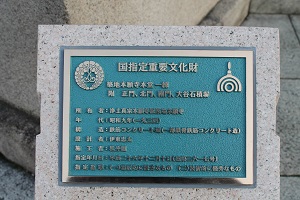 On the premises, stone lantern (this is not an important cultural property) On the premises, stone lantern (this is not an important cultural property)
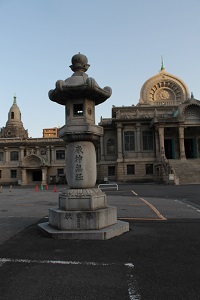 Shinran saint statue on the premises (this is not an important cultural property) Shinran saint statue on the premises (this is not an important cultural property)
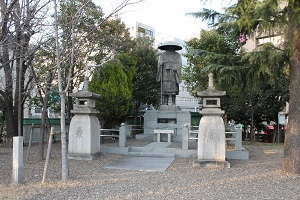 The main gate and masonry fence, which are part of important cultural properties The main gate and masonry fence, which are part of important cultural properties
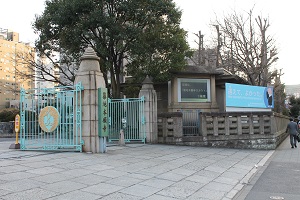 South Gate, a part of Important Cultural Properties South Gate, a part of Important Cultural Properties
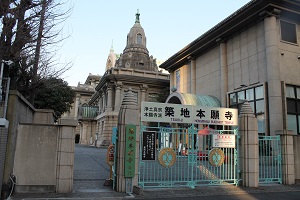 There is also a cafe and accommodation on the premises. There is also a cafe and accommodation on the premises.
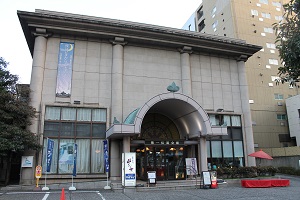
[CAM]
February 22, 2016 09:00
The Nikkei Shimbun on February 13 reported on the opening of Tsukiji's commercial facility "Tsukiji Fish Bank".
|
> Tsukiji Fish Bank Opened on October 15, 61 vendors, Chuo-ku, and rats before and after relocation to maintain liveliness outside the venue.
|
|
2016/02/13 Nihon Keizai Shimbun Regional Economics Tokyo, Page 15, 704 characters
|
|
Chuo-ku, Tokyo has decided to open on October 15 for the Tsukiji Fish Bank, a commercial facility that is under construction outside the Tsukiji Market in Tokyo. 61 businesses move in. Even after the market itself moved to Toyosu Market (Koto-ku) on November 7, we aim to maintain the liveliness of the out-of-office area by making use of the brand power of Tsukiji.
・・・・・・・
Chuo-ku will start removing rats around Tsukiji Market before and after the relocation. In May and August, work on the injection of chemicals into the burrow and blocking the burrow. A box for capture will be set up for planting, etc., and equipment will be installed to spray chemicals on sewer manholes to catch rats. From September, residents living nearby will be given adhesive sheets to catch rats. Approximately 80,000 copies will be prepared and will continue to be distributed until March next year.
Construction of the Tsukiji Fish Bank
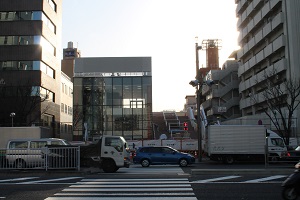 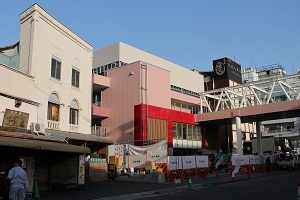 The area outside Tsukiji used to be the temple town of Honganji. Myosenji Temple is still on the floor of the building. The area outside Tsukiji used to be the temple town of Honganji. Myosenji Temple is still on the floor of the building.
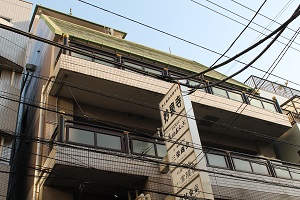
|
[CAM]
February 13, 2016 14:00
The Toysler Memorial Hall of St. Luke's International Hospital
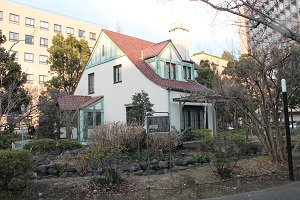
Location 1, Akashicho, Chuo-ku0(St. Luke International Hospital)
In 1933, the Toysler Memorial Hall was built at 19 Akashi-cho on the banks of the Sumida River as a missionary hall at St. Luke International Hospital.
The designer was an American architect J. V. W. Bergaminy, and the construction was performed by Shimizu Gumi (currently Shimizu Corporation). The skeleton of the building was a two-story reinforced concrete wooden building, which is rare for residential buildings in the early Showa era, and was a solid-style building reminiscent of a European mountain cottage.
Demolition work was carried out in 1989, and it was relocated and restored to its current location in February 1998. In restoring, we accurately record the construction technology and structural features at the time of its foundation, and use reusable materials as much as possible.
The exterior is a half-timber-style design that expresses pillars and beams outside. The interior is designed with a tuder and gothic style, and the interior of the building can be seen in the entrance hall and living room.
This building tells the history of St. Luke International Hospital and is a valuable cultural property that conveys a part of the history of Akashicho, which has been handed down since the Tsukiji Reservation period.
March, 2006 Chuo-ku Board of Education
Stone mark of the U.S.
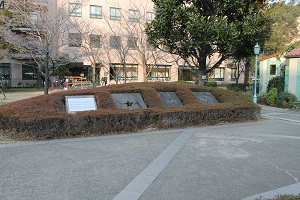 The U.S. Embassy was opened in Zenpukuji Temple, Motoazabu 1-6, Minato-ku by Harris in 1859, but was newly built in this area in Tsukiji's foreign settlement in December 1875. I adjusted it for the first time. Later, it was relocated to the current location of Akasaka in March 1890, and became the current embassy. The U.S. Embassy was opened in Zenpukuji Temple, Motoazabu 1-6, Minato-ku by Harris in 1859, but was newly built in this area in Tsukiji's foreign settlement in December 1875. I adjusted it for the first time. Later, it was relocated to the current location of Akasaka in March 1890, and became the current embassy.
As a result of the last relocation, eight stone markers of Komatsu stone were left in this area. The stone mark is engraved with three types of sculptures: a white head eagle, a star flag, and a star, and the white head eagle is an American national bird, and the 13 stars carved in the star flag indicate the early 13 states.
Three of the eight stone markers were donated to the American Embassy in Akasaka in October 1984 as a symbol of Japan-US friendship, and are now located in the front yard of the embassy. The remaining five stone marks have been registered as a Chuo Ward Cultural Property as a way to convey the settlement era of Tsukiji, three of which will be installed here and two in St. Luke Garden.
May, 1998 St. Luke's International Hospital
[CAM]
February 13, 2016 09:00
Catholic Tsukiji Church Cathedral
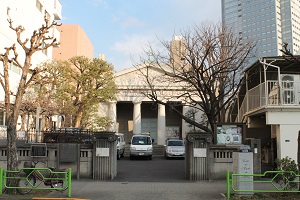
Location 5-26, Akashicho, Chuo-ku
The predecessor of the Catholic Tsukiji Church was the Inaribashi Church, which was opened in 1871 by Father Maran of the Paris Foreign Mission in 1871 by renting a merchant near Inari Bridge in the gunshot. In 1874 (1874), the priest borrowed Tsukiji Reservation No. 35.36 under the name of the missionary, and built a priest's house and a cathedral here. In 1878 (1878), a Gothic-style cathedral was dedicated here, which was destroyed by the Great Kanto Earthquake, and the current cathedral was rebuilt in 1927. The cathedral looks stone, but it is actually a wooden building, and the mural is painted with mortar.
The bell used in the old cathedral was made in Renne, France in 1876 (Meiji 9), and was named "Janne Louise of Edo" by Father Mareshal, the priest at the time, and is still kept in the church.
The church cathedral and bells are registered as Chuo Ward Cultural Properties as valuable cultural properties left in Akashicho, where the foreign settlement was once located.
March, 2001
Chuo-ku Board of Education
Roses and tulip sculptures in front of the roof
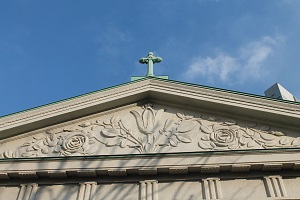 The Tsukiji Church Cathedral is designated as a Tangible Cultural Property inhabitant of a ward and a Historic buildings selected by Tokyo (page 152 of the Monoshiri Encyclopedia). The signboard is designated by the Historic buildings, which was selected by the Tokyo Metropolitan Bureau of Life and Culture, Tangible Cultural Property. The Tsukiji Church Cathedral is designated as a Tangible Cultural Property inhabitant of a ward and a Historic buildings selected by Tokyo (page 152 of the Monoshiri Encyclopedia). The signboard is designated by the Historic buildings, which was selected by the Tokyo Metropolitan Bureau of Life and Culture, Tangible Cultural Property.
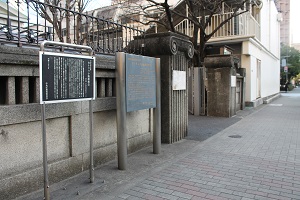
A monument to the birthplace of Xiaosei Gakuen, right in front of the gate. The background is Akashi Elementary School, with a little "gas streetlight pillar" (page 65 of "monoshiri Encyclopedia") on the left.
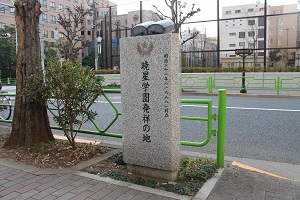
|
Links
|

